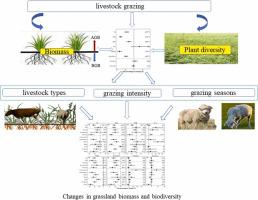当前位置:
X-MOL 学术
›
Field Crops Res.
›
论文详情
Our official English website, www.x-mol.net, welcomes your
feedback! (Note: you will need to create a separate account there.)
Effects of grazing on grassland biomass and biodiversity: A global synthesis
Field Crops Research ( IF 5.6 ) Pub Date : 2023-12-02 , DOI: 10.1016/j.fcr.2023.109204 Fengfeng Cao , Weibin Li , Yuan Jiang , Xiaoling Gan , Chuanyan Zhao , Jiancheng Ma
Field Crops Research ( IF 5.6 ) Pub Date : 2023-12-02 , DOI: 10.1016/j.fcr.2023.109204 Fengfeng Cao , Weibin Li , Yuan Jiang , Xiaoling Gan , Chuanyan Zhao , Jiancheng Ma

|
Livestock grazing, a common method of grassland utilization, has profound effects on the plant biomass and biodiversity of grassland ecosystems. However, the overall directions and magnitudes of such effects, especially involving multiple livestock types and grazing seasons, remain poorly understood on a global scale. We conducted a meta-analysis to evaluate the size and direction of the overall effects of grazing on grassland plant biomass and plant diversity; and to estimate the variation of these responses with area types, livestock types, grazing seasons, and grazing intensities. We performed a comprehensive search of the Web of Science® and the China National Knowledge Infrastructure (CNKI) (1950–2019) using certain search terms, and considered the studies cited by several recent related syntheses. We compiled data from 175 field manipulative studies at 200 sites by selecting studies that satisfied five criteria. Grazing significantly decreased aboveground (−38.5%), belowground (−14.7%), and total biomass (−20.6%), but did not significantly change root–shoot ratio, species richness, or evenness. The effects of grazing on plant biomass and diversity depended on climate types and grazing patterns. Specifically, grazing significantly decreased plant total biomass and belowground biomass in dry areas only, but increased rootshoot ratio in wet areas only. Growing season and year-long grazing decreased total biomass, whereas non-growing season grazing had not changed total biomass. Among livestock types (bulk feeder, concentrate selectors, intermediate feeder or mixed), only intermediate feeder grazing significantly decreased belowground biomass (−16.5%) and total biomass (−25.3%). Heavy grazing significantly decreased belowground biomass (−19.2%), total biomass (−24.3%) and plant evenness (−21.2%), but not light and moderate grazing. Aboveground biomass was more sensitive to grazing than belowground biomass, and only over grazing decreased grassland biodiversity. Under the same grazing intensities, mixed livestock or bulk feeder grazing in the non-growing season probably is one of the ways to maintain plant diversity and sustainable development of grassland agriculture. Our results highlight the key role of grazing patterns and climate types in mediating plant biomass and biodiversity in response to grazing disturbance, and should be considered in devising the sustainable grazing management of grasslands.
更新日期:2023-12-02






























 京公网安备 11010802027423号
京公网安备 11010802027423号